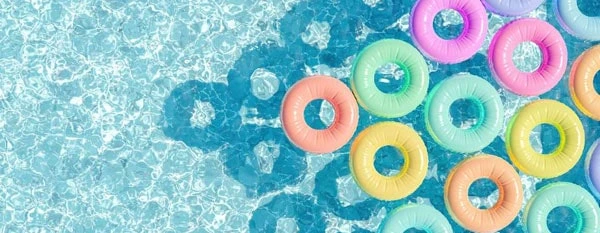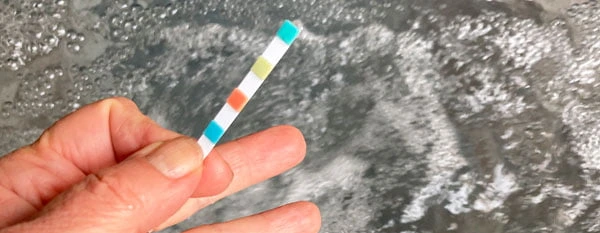Saltwater pools have become increasingly popular among pool owners due to their low maintenance and cost-effectiveness. Owners like the fact that they no longer constantly have to add Chlorine sanitation products to the pool water. However, one important component of a saltwater pool is the salt cell, which is responsible for producing chlorine to keep the pool clean and the water clear.
One of the big benefits of a saltwater chlorination cell is that it is supplying a more consistent supply of Chlorine for sanitization. If you are interested in the chemical details of the process, there is a good post on Wikipedia. If your salt cell is breaking down or malfunctioning, you lose the benefit of consistency, so it’s important to replace or maintain your salt cell when it’s time.
Over time, the salt cells can become worn out and need to be replaced. But how does a pool owner know when it’s time to replace the cell? There are a few signs to look out for, such as a decrease in chlorine production, cloudy water, and an increase in algae growth.
By understanding these signs, pool owners can take the necessary steps to ensure their pool remains in top condition and continues to provide a refreshing swim for years to come.

What is a Salt Cell?
A salt cell is a critical component of a saltwater pool system that produces chlorine to sanitize the pool water. It is also known as a salt chlorinator or salt chlorine generator. The cell contains a series of titanium plates coated with a thin layer of precious metals such as ruthenium, iridium, or platinum.
When saltwater passes through the salt cell, an electric current is applied to the plates, which triggers a chemical reaction that converts the salt into chlorine gas. The chlorine gas then dissolves in the water, forming hypochlorous acid, which is a powerful sanitizer that kills bacteria, viruses, and other harmful contaminants in the pool water.
Salt cells are designed to last for several years, but they do require regular maintenance to ensure optimal performance. Over time, the precious metal coating on the plates can wear off, reducing the efficiency of the cell and leading to lower chlorine levels in the pool water.
To maintain the salt cell, it is essential to monitor the salt level in the pool water regularly. If the salt level is too low, the cell will not be able to produce enough chlorine to sanitize the water effectively. On the other hand, if the salt level is too high, it can damage the cell and reduce its lifespan.
If you came to this page looking for information on how much pool salt you should be using with your saltwater salt cell, please see the article on Saltwater Pools: How Much Salt For Proper Chlorination? If testing the current level of salt in your pool or spa is an issue, this article addresses that subject: How Accurate Are Pool Salt Test Strips. The article also examines other methods of testing such as digital meters.
Test Your Saltwater!
A number of different factors can affect whether you have the correct amount of chlorine being supplied to your pool. Salt cells can be expensive, so it is good to rule out the other issues before just replacing the cell. The first line of defense is to test!

Test the Chlorine Level
If you haven’t already done so, test the Chlorine level. It’s good to know when troubleshooting if the level is just low or if there is no Chlorine. Some test strips will show you both total chlorine and free chlorine, and will show you the optimum range right on the test strip container.
Sometimes, when a Salt cell is just starting to fail, you can get inconsistent available Chlorine levels from different spots in your pool. Here is a way to get a really good reading of how much Chlorine that the salt cell is producing:
- Find a small bottle or jar – preferably one where your thumb fits over the top of the bottle neck to stop water from flowing in or out. If you don’t have that, just save the lid for the container. Plastic containers are the best – this is a pool area afterall!
- Your container should be clean and empty. Make sure the pumps are running and go to the pool jets that are closest to the salt cell. Close up your bottle, stick it right in front of the jets, then let the bottle fill up with water. While still in front of the jets, put your thumb over the bottle opening (or put the lid back on).
- Test the available chlorine level with the water from the bottle. You should get a more consistent reading, and it also will probably be a little higher than what you picked up from any other random spot in the pool. This is especially true if you use Test Strips, because they usually are testing the water right at the surface of the pool.
Now that you have your testing container, save it! You can use it next time, and you may also get more consistent readings from your other measurement levels.
Test the Salt Level
If your salt level has gotten too low, your salt cell can’t convert enough Chlorine. Sometimes when it seems like you recently added salt, time has slipped away from you.
In general, you are trying to maintain a salt concentration of 3200 ppm. Check with your owner’s manual to see if your salt cell varies from that amount, but it should be close. For convenience, here is the link for how much salt to add: Saltwater Pools: How Much Salt For Proper Chlorination? That article will also provide the link to the 8-in-1 Test Strips we like.
Test the Stabilizer Level
Stabilizer is the stuff that helps keep the generated chlorine in your pool and helps to slow down the process of the sunlight naturally dissipating it. People who use Chlorine tablets are adding stabilizer every time they add tablets, but when you have a saltwater chlorinating cell system, you need to add stabilizer and test for it until you have a good handle on how much your pool tends to need through the seasons.
There are test kits for Stabilizer and they come with good & complete instructions, so I won’t duplicate that information here.
Test Other Water Quality Levels
If pH, alkalinity, or cyanuric acid levels are out of balance, they can contribute to making it more difficult for the saltwater cell to do it’s job. Test and then adjust these levels to bring them into range.
This all sounds like lots of test strips, but these days there are convenient products that combine most of the testing into a single strip.
Troubleshooting Saltwater Chlorination Issues
Now that you know how your water tests out and you’ve corrected any deficiencies in salt or stabilizer levels and your pH and alkalinity are within proper ranges, what’s next?
Check the System Control Panel
Most newer Saltwater Pool systems have a control panel to help you track down issues. The exact text of messages vary a little bit depending on which system you have, but typical messages are:
No Flow / Low Flow – Indicates a problem with the pump, the filter, or less often with the salt cell.
Inspect Cell – obviously, this type of message says “look at the salt cell first”. Other systems may simply have a red light indicator that comes on associated with the salt cell.
Some systems may also direct you to the system component that is not sending back a good indicator. You can check with your owner’s manual, but most of the time the messages are clear and simple.
Check the System Pump
Things to look for with the system pump:
- Is it running? Usually you can just hear that the pump is running.
- Is it primed? Typically systems come with an area at the top of the pump piping where you can see that there is water available at the top of the pump supply. Make sure there isn’t a air pocket in this piping.
Check the System Filter
Things to look for with the system filter:
- How long ago did you last change the filter? No really, do you remember? (Self: “Didn’t I just change that filter?”). Maybe it’s been a while.
- Some systems have a pressure gauge or indicator on the filtration cartridge. High pressure in front of the filter unit indicates a clogged filter. Remove the filter, visually inspect it, and try cleaning it out with high pressure clear water. You can take it to the car wash and try cleaning it with the ‘High Pressure Rinse’ setting, but make SURE to clear out the hose line of all soapy and waxy stuff from the previous car before aiming the hose at your filter!
- After cleaning, put the filter back in the system. If the pressure goes down significantly, then check to see if the low flow indicator on your system clears out. If not, replace the filter with a brand new one.
- If you suspect that maybe it is the pressure indicator that isn’t working, you can try just taking the filter out of the system temporarily and turn the system back on. If the pressure reading goes down, it’s probably the filter that needs changing. If you get a similar pressure reading as before, you may need a technician to replace the pressure gauge.
Check the Salt Cell
Turn off your system and disconnect the Salt Cell so you can visually inspect it. You may have a valve where you can drain down or release pump pressure – these can be good to use to avoid getting sprayed if you have this feature. Usually there are two large PVC nuts on each end of the cell that connect to the plumbing housing. Another way to release any pressure is just to turn the nuts slowly when you remove the cell.
- Any signs of cracking or disintegration on any of the outer parts of the cell indicate replacement.
- Look inside the cell – there should be no build up of white stuff (usually Calcium) or any other discoloration (iron or other mineral buildup from excessively hard water). You should be able to clearly see the thin parallel metallic plates that form the interior of the salt cell.
- If you do see buildup, don’t try to remove it manually (such as with a screwdriver or spatula), but follow the instructions for dissolving the buildup by soaking it an acid bath (more about this below).
If you don’t see buildup or any other visual signs, it is also possible that the metal coating on the thin parallel plates can slowly break down and become less effective at producing chlorine. This usually has to do with age of the cell – typical expected life is 3 to 5 years, and sometimes a little longer if the cell capacity is oversized with respect to the pool water volume.
Other Stuff that Can Go Wrong
If you’ve checked everything and it seems like it is alright, there are a few other components of the system that might contribute to a system problem, such as a non-operable or ‘sticky’ flow switch, or even the main control panel/control system for the pool. In these cases, you probably are stuck calling the system maintenance professionals.
Factors that Affect the Life of your Salt Cell
Salt Cells, especially well made ones, tend to have a pretty long usable life in terms of several years. Some factors that can affect how much use you get from the cell include:
- How ‘hard’ is your water? If it contains a lot of Calcium, Iron, and other minerals, they can reduce the life of your salt cell. I lived at a home in the mountains for many years where we had well water instead of city supplied water, and all the extra dissolved solids in the water affected many of our household systems regarding water.
- Bather Load – how many people are using the pool how often?
- Rain – how much water is entering your pool from the environment vs. via your water supply?
- Sunshine – Sunlight exposure accelerates how much Chlorine breaks down through natural chemical processes. Your salt cell has to keep up production to match that process.
- Covered Pools – Having a your pool covered some of the time can be a factor in lots of pool maintenance issues: evaporation, chlorine breakdown, filter load, etc.
- Size of your pool compared to the capacity of the salt cell – somewhat oversized salt cells can demonstrate longer lifetimes than ‘right sized’ or under sized cell capacities.
- Regular maintenance of water quality – Pools that consistently have the salt, pH, alkalinity and other water quality components balanced will generally experience salt cells that have longer lifetimes.
- Regular maintenance of filtration system may improve salt cell performance.
What Can Happen if A Damaged Salt Cell Is Not Replaced
Ignoring a damaged or inefficient salt cell in your saltwater pool can lead to various undesirable outcomes. Primarily, it can disrupt the proper chemical balance of your pool, leading to unsanitary swimming conditions.
When the salt cell isn’t working efficiently, it can’t generate enough chlorine. This failure can cause the pool water to become unsanitary, leading to algae growth and potentially harmful bacteria. Over time, swimming in such conditions can lead to skin irritations and eye infections.
A damaged salt cell might also lead to excessive salt levels. When a cell is unable to convert salt into chlorine effectively but you continue to add salt on a schedule, the salinity in your pool can increase. High salinity can be corrosive to pool equipment, the pool’s interior surface, and even the surrounding decking.
An efficiently functioning cell is the key to the optimal performance of your saltwater pool.
How Often Should a Salt Cell Be Replaced in A Saltwater Pool
On average, a pool salt need replacing every 3 to 7 years. If you run your saltwater pool all year round or use it frequently, the salt cell may need replacing closer to the 3-year mark. On the other hand, if your pool usage is seasonal or relatively low, your salt cell could last up to 7 years.
Regular maintenance and monitoring of your pool’s chemistry can also extend the lifespan of your salt cell. This involves keeping your pool clean, ensuring the correct water balance, and inspecting the cell for any scale build-up.
In addition, the quality and brand of the salt cell can also influence its lifespan. Higher quality cells may come with a higher price tag, but they often last longer and perform more efficiently.
Ultimately, it’s important to keep an eye on your pool’s chlorine levels and the condition of your salt cell. If you notice a decline in chlorine production or visible signs of wear and tear on the cell, it may be time to consider a replacement.
Can a Salt Cell Be Repaired, or Does It Need to Be Replaced
Some common problems, like scale build-up, can often be addressed through cleaning and maintenance. This process typically involves soaking the salt cell in a mixture of water and a mild acid, like muriatic acid or white vinegar, to dissolve the deposits. The salt cell manufacturer usually supplies the ratio and type of acid that works best with their product, so check the instructions that came with your cell.
However, if your cell is failing due to age or more serious damage, such as a broken plate or worn-out coating, it probably is not be repairable. In these cases, replacing the cell is usually the most effective and reliable course of action.
The cost of professional repairs can sometimes approach the cost of a new salt cell. Given that a new cell might come with a warranty and the certainty of proper functioning over that time period, replacement often proves to be the more economical choice in the long run. It is also one less thing to worry about.
What Are the Costs Associated with Replacing a Salt Cell
The cost of replacing a salt cell in your saltwater pool can vary based on a few key factors: the type and model of the cell, whether you choose to replace it yourself or hire a professional, and where you live, as regional price variations can apply.
The price of a new salt cell itself generally ranges between $300 and $1000, depending on the specific model and brand. Higher-end models might offer advanced features such as self-cleaning or extended lifespan, which can justify the additional expense. Hiring a professional to do the replacement will cost an additional $50 to $150+, depending on the complexity of the installation, local rates and most charge a trip fee or base service fee. Some places might only install a salt cell that they provide (instead of one that you bought elsewhere), so be sure to ask about that before you schedule an appointment.
Also, if your pool’s chlorination system has suffered damage due to a malfunctioning cell, you may also face additional repair costs.
Remember, while the upfront cost might seem significant, replacing a failing cell is an investment in the health and longevity of your pool. Not only does a functioning salt cell ensure the cleanliness and safety of your pool, but it also helps to prevent more costly damage to your pool’s equipment and infrastructure down the line.
Are There Specific Brands or Types of Salt Cells that Are More Durable than Others
Certainly, the durability and reliability of salt cells can vary significantly based on the brand and model. While every pool and saltwater system is different, and we do not endorse specific brands, there are a few widely recognized manufacturers in the industry known for their quality products. These include Hayward, Pentair, and Zodiac. For convenience, here are samples of each brands offerings. Be sure to carefully look at each listing for options on cell technology types, how many gallons they support and so forth before selecting a replacement cell.
Hayward has a reputation for producing salt cells that are robust and reliable, with models designed for different pool sizes and needs. This link takes you to the basic model and the 15000 gallon capacity cell, but links on the same page give you other options to match your pool configuartion.
Pool owners like Pentair Sall Cells in part because they come equipped with diagnostic information for monitoring the cell. This cell has fewer visible options listed, so be sure to check the product details to make sure it will work in your system. Installation, Safety and User Manual links are supplied on the page where this link goes.
Zodiac, particularly the Jandy series, is recognized for its efficient and durable salt cells. This link takes you to one particular model, so you might want to click the Category breadcrumb to view other options.
When selecting a cell, it’s important to consider more than just the brand. Look for features that enhance durability and efficiency, such as self-cleaning capabilities, clear cell housing for easy inspection, and compatibility with your existing chlorination system.
Also, check out customer reviews and ratings to get a sense of the product’s performance and longevity. Consider the warranty provided by the manufacturer, as this can offer an additional level of security for your investment. Your original pool control system manual may also give you parameters to consider when selecting a replacement salt cell.
How do You Replace a Salt Cell in a Saltwater Pool
Replacing a salt cell in a saltwater pool is a relatively straightforward process that many pool owners can handle themselves. Some of the cells have Installation Manual links available online so you can review them and see if the job sounds like one that you want to tackle.
Here’s a general guide to help you through the steps:
- Turn Off the Power: Always start by turning off the power to your pool’s chlorination system to ensure safety while you’re working.
- Remove the Old Salt Cell: Locate the salt cell in your system. It’s typically situated between the pool’s filter and return jet. Once found, disconnect it from the power source and then unscrew or unfasten the cell from the plumbing. Turn the big PVC nuts slowly to release any water pressure that may be in the water line. Pay attention to the direction of flow – you’ll want to know that soon.
- Inspect the Area: Before installing the new cell, inspect the nearby plumbing lines and connections for any signs of wear, damage, or leaks that could affect the new cell’s operation.
- Install the New Salt Cell: Screw or fasten the new cell into place, ensuring it’s securely connected to the plumbing. Make sure it’s oriented in the correct direction – many cells will have an arrow indicating the direction of water flow.
- Reconnect the Power: Reconnect the new salt cell to the power source. Ensure the connections are secure.
- Turn On the Power: Turn the power back on and check the chlorination system’s operation. Many systems will have a light or indicator to show that the cell is working correctly.
- Check for Leaks: Finally, look for any leaks in the area around the new cell. If you see water escaping, turn off the power and tighten the connections. Sometimes you can have a very slow leak, so even if everything seems water tight at first, come back in an hour or two and check again.
Remember, this is a general guide, and the exact steps can vary depending on your specific pool system and the type of salt cell you’re installing. Always refer to the manufacturer’s instructions provided with your new cell. If you’re unsure or uncomfortable with any part of the process, don’t hesitate to hire a pool professional to handle the job.
Should You Hire a Professional?
Whether a pool owner can replace a salt cell themselves largely depends on their comfort level and experience with pool maintenance. The process of replacing a cell is relatively straightforward and can often be handled by a DIY-minded pool owner.
The steps…mentioned in detail up above…typically involve turning off the power to the chlorination system, removing the old cell, installing the new one, and then turning the power back on.
However, if you are unfamiliar with your pool’s chlorination system, or if you’re not comfortable handling pool equipment, it may be best to hire a professional. A professional pool technician will have the necessary training and experience to replace the cell quickly and safely, ensuring it’s properly installed and functioning correctly.










